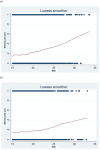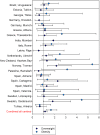Overweight/obesity and respiratory and allergic disease in children: international study of asthma and allergies in childhood (ISAAC) phase two
- PMID: 25474308
- PMCID: PMC4256390
- DOI: 10.1371/journal.pone.0113996
Overweight/obesity and respiratory and allergic disease in children: international study of asthma and allergies in childhood (ISAAC) phase two
Erratum in
-
Correction: Overweight/Obesity and Respiratory and Allergic Disease in Children: International Study of Asthma and Allergies in Childhood (ISAAC) Phase Two.PLoS One. 2015 Apr 22;10(4):e0126678. doi: 10.1371/journal.pone.0126678. eCollection 2015. PLoS One. 2015. PMID: 25901748 Free PMC article. No abstract available.
Abstract
Background: Childhood obesity and asthma are increasing worldwide. A possible link between the two conditions has been postulated.
Methods: Cross-sectional studies of stratified random samples of 8-12-year-old children (n = 10 652) (16 centres in affluent and 8 centres in non-affluent countries) used the standardized methodology of ISAAC Phase Two. Respiratory and allergic symptoms were ascertained by parental questionnaires. Tests for allergic disease were performed. Height and weight were measured, and overweight and obesity were defined according to international definitions. Prevalence rates and prevalence odds ratios were calculated.
Results: Overweight (odds ratio = 1.14, 95%-confidence interval: 0.98; 1.33) and obesity (odds ratio = 1.67, 95%-confidence interval: 1.25; 2.21) were related to wheeze. The relationship was stronger in affluent than in non-affluent centres. Similar results were found for cough and phlegm, rhinitis and eczema but the associations were mostly driven by children with wheeze. There was a clear association of overweight and obesity with airways obstruction (change in FEV1/FVC, -0.90, 95%-confidence interval: -1.33%; -0.47%, for overweight and -2.46%, 95%-confidence interval: -3.84%; -1.07%, for obesity) whereas the results for the other objective markers, including atopy, were null.
Conclusions: Our data from a large international child population confirm that there is a strong relation of body mass index with wheeze especially in affluent countries. Moreover, body mass index is associated with an objective marker of airways obstruction (FEV1/FVC) but no other objective markers of respiratory and allergic disorders.
Conflict of interest statement
Figures
References
Publication types
MeSH terms
Grants and funding
LinkOut - more resources
Full Text Sources
Other Literature Sources
Medical



